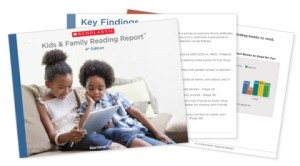 The number of kids reading ebooks has nearly doubled since 2010, according to Scholastic’s Kids & Family Reading Report, which was released today. The national survey of kids ages 6–17 and their parents also found that half of kids ages 9–17 say they would read more books for fun if they had greater access to ebooks—although 80 percent of kids who read ebooks say they still read books for fun primarily in print.
The number of kids reading ebooks has nearly doubled since 2010, according to Scholastic’s Kids & Family Reading Report, which was released today. The national survey of kids ages 6–17 and their parents also found that half of kids ages 9–17 say they would read more books for fun if they had greater access to ebooks—although 80 percent of kids who read ebooks say they still read books for fun primarily in print.
“We are seeing that kids today are drawn to both print books and ebooks, yet e-reading seems to offer an exciting opportunity to attract and motivate boys and reluctant readers to read more books,” says Francie Alexander, Chief Academic Officer, Scholastic, in a statement about the report. “While many parents express concern over the amount of time their child spends with technology, nearly half do not have a preference of format for their child’s books. The message is clear—parents want to encourage more reading, no matter the medium.”
According to the study—the fourth biannual report from Scholastic and the Harrison Group, a marketing and strategic research consulting firm—the number of kids who have read an ebook has reached 46 percent, compared with only 25 percent in 2010, while 49 percent of parents feel their kids do not spend enough time reading books for fun, an increase from only 36 percent in 2010. Overall, 72 percent of parents show an interest in having their kids read ebooks, the survey found.
The findings reveal the potential for ebooks to motivate boys, who are more commonly known to be reluctant readers, to read more, Scholastic says, noting that one in four boys who has read an ebook says he is now reading more books for fun.
Ebooks may also be the key to transition moderately frequent readers (defined as kids who read one to four days a week) to frequent readers (those who read five to seven days a week), Scholastic says; according to the study, 57 percent of moderately frequent readers who have not read an ebook agree that they would read more if they had greater access to them.
Even so, the love of and consistent use of print books is evident, Scholastic says, with 58 percent of kids ages 9–17 saying they will always want to read books printed on paper even though there are ebooks available, a slight decline from 66 percent in 2010 This reveals “the digital shift in children’s reading that has begun,” Scholastic says in the report.
The study also looked at the influences that impact kids’ reading frequency, and parents ranked extremely high, Scholastic says. According to the study, having a reading role-model parent or a large book collection at home has a greater impact on kids’ reading frequency than does household income. Plus, building reading into kids’ daily schedules and regularly bringing home books for children positively impacts kids’ reading frequency.
Scholastic also notes that the study shows kids prefer ebooks to print books when they do not want their friends to know what they are reading, and when they are out and about/traveling, but kids prefer print books for sharing with friends and reading at bedtime. Overall, kids are more likely to finish a book that they choose themselves, regardless of whether the format is digital or in print.
The study was conducted by Scholastic and managed by Harrison Group, a YouGov Company. Survey data were collected by GfK, and the source of the survey sample of 1,074 pairs of children age 6-17 and their parents was GfK’s nationally representative KnowledgePanel®.


